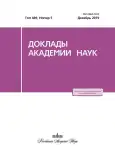Textured materials with extreme wettability for water harvesting from aerosols
- Authors: Emelyanenko K.A.1, Melnikov S.N.2, Proshin P.I.2, Domantovsky A.G.1, Emelyanenko A.M.1, Boinovich L.B.1
-
Affiliations:
- Frumkin Institute of Physical Chemistry and Electrochemistry Russian Academy of Sciences
- Higher Chemical College, Dmitry Mendeleev University of Chemical Technology of Russia
- Issue: Vol 489, No 5 (2019)
- Pages: 478-482
- Section: Physical chemistry
- URL: https://journals.eco-vector.com/0869-5652/article/view/18842
- DOI: https://doi.org/10.31857/S0869-56524895478-482
- ID: 18842
Cite item
Abstract
The creation of methods for complete and cost-effective collection of water droplets from an aerosol which arises as a by-product of the low-potential heat uptake from industrial devices, is one of the key tasks of rational use of water resources contributing to the improvement of the environment near large industrial enterprises. This paper shows how the application of materials with extreme wettability and a specific surface topography in spray separators can significantly increase the efficiency of water collection.
About the authors
K. A. Emelyanenko
Frumkin Institute of Physical Chemistry and Electrochemistry Russian Academy of Sciences
Author for correspondence.
Email: emelyanenko.kirill@gmail.com
Russian Federation, 31, Leninsky prospect, Moscow, 119071
S. N. Melnikov
Higher Chemical College, Dmitry Mendeleev University of Chemical Technology of Russia
Email: emelyanenko.kirill@gmail.com
Russian Federation, 47, Lenin prospect, Moscow, 119991
P. I. Proshin
Higher Chemical College, Dmitry Mendeleev University of Chemical Technology of Russia
Email: emelyanenko.kirill@gmail.com
Russian Federation, 47, Lenin prospect, Moscow, 119991
A. G. Domantovsky
Frumkin Institute of Physical Chemistry and Electrochemistry Russian Academy of Sciences
Email: emelyanenko.kirill@gmail.com
Russian Federation, 31, Leninsky prospect, Moscow, 119071
A. M. Emelyanenko
Frumkin Institute of Physical Chemistry and Electrochemistry Russian Academy of Sciences
Email: emelyanenko.kirill@gmail.com
Russian Federation, 31, Leninsky prospect, Moscow, 119071
L. B. Boinovich
Frumkin Institute of Physical Chemistry and Electrochemistry Russian Academy of Sciences
Email: emelyanenko.kirill@gmail.com
Academician of the Russian Academy of Sciences
Russian Federation, 31, Leninsky prospect, Moscow, 119071References
- Hung D.V., Tong S., Nakano Y., et al. Measurements of Particle Size Distributions Produced by Humidifiers Operating in High Humidity Storage Environments // Biosystems Engineering. 2010. V. 107. № 1. P. 54-60.
- Xu T., Lin Y., Zhang M., et al. High-efficiency Fog Collector: Water Unidirectional Transport on Heterogeneous Rough Conical Wires // ACS Nano. 2016. V. 10. № 12. P. 10681-10688.
- Kostal E., Stroj S., Kasemann S., et al. Fabrication of Biomimetic Fog-Collecting Superhydrophilic-Superhydrophobic Surface Micropatterns Using Femtosecond Lasers // Langmuir. 2018. V. 34. № 9. P. 2933-2941.
- LaPotin A., Kim H., Rao S.R., et al. Adsorption-Based Atmospheric Water Harvesting: Impact of Material and Component Properties on System-Level Performance // Accounts of Chemical Research. 2019. V. 52. № 6. P. 1588-1597.
- Emelyanenko A.M., Shagieva F.M., Domantovsky A.G., et al. Nanosecond Laser Micro- and Nanotexturing for the Design of a Superhydrophobic Coating Robust Against Long-Term Contact with Water, Cavitation, and Abrasion // Applied Surface Science. 2015. V. 332. P. 513-517.
- Boinovich L., Emelyanenko A.M., Korolev V.V., et al. Effect of Wettability on Sessile Drop Freezing: When Superhydrophobicity Stimulates an Extreme Freezing Delay // Langmuir. 2014. V. 30. № 6. P. 1659-668.
- Park K.C., Chhatre S.S., Srinivasan S., et al. Optimal Design of Permeable Fiber Network Structures for Fog Harvesting // Langmuir. 2013. V. 29. № 43. P. 13 269-13 277.
Supplementary files








